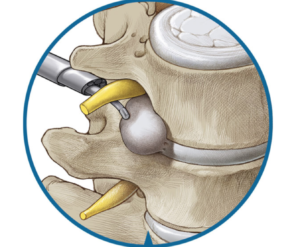FORAMINOTOMY
If you suffer from back pain, burning or tingling sensations , please Schedule an appointment with one of our orthopedic specialists as soon as possible.
What is a Foraminotomy Procedure?
A minimally invasive outpatient procedure, a foraminotomy widens the available room for the nerve and relieve the compression. Best performed by a fellowship-trained spine surgeon Most surgeons have high success rates with Lumbar decompression, or foraminotomy.
Foraminotomy means surgically widening the of the spinal opening or foramen. Foramen means refers to the openings in the vertebrae through which the spinal cord passes. The Spinal Surgeon exposes the spinal cord at the site of compression and attempts to widen the foramen in the affected vertebra thereby removing any obstructions in the path of the spinal cord.
Neck and back problems can occur due to prolonged rounded posture, long screen hours, falls, accidents, or a disease. If the situation aggravates and one of these factors causes compression of nerves in the spinal column, foraminotomy can be done.
Physicians often employ less techniques to start – such as physical therapy or injections. If a patient elects for surgery, a spinal specialist or neurosurgeon performs foraminotomy as the last resort when conventional methods of physiotherapy and medication fail to mitigate the pain or discomfort. Most spinal surgeons consider the procedure minimally invasive.
With open procedures, Researchers report high success for open paraspinal foraminotomy between 72% to 83%. Considered as the top standard for surgical treatment of lumbar foraminal or far lateral stenosis, most patients report high satisfaction rates associated with electing for the operation.
Depending on the affected area, the approach for foraminotomy varies. For example, in the neck region, the surgeon might approach the neck anteriorly or posteriorly[1].
Foraminotomy has a high success rate. Patients typically return to work or the quality lives within eight weeks of surgery. Often times, surgeons prescribe post-surgical physical therapy to ensure the best possible patient outcomes.
Foraminotomy Procedure Benefits
Foraminotomy relieves compression on spinal nerves caused by narrowed openings in the spinal column known as neural foramina. By widening these openings through the removal of tissue or bone, foraminotomy effectively alleviates symptoms such as pain, numbness, and weakness in the arms or legs.
The benefits of foraminotomy include significantly reducing pain, improving mobility, and enhancing the quality of life for individuals suffering from conditions like spinal stenosis, herniated discs, or bone spurs. Foraminotomy restores normal nerve function, prevents further damage, and helps in maintaining overall well-being.
Furthermore, foraminotomy is less invasive compared to traditional open-back surgery, resulting in shorter recovery times, lower risk of complications, and smaller incisions. This translates to reduced postoperative pain, shorter hospital stays, and a faster return to daily activities for patients undergoing this procedure. In conclusion, foraminotomy presents a promising solution for those seeking relief from debilitating spinal nerve compression symptoms.
Foraminotomy Procedure Steps
During a foraminotomy procedure, the surgeon follows several key steps to alleviate compression on spinal nerves caused by narrowed neural foramina openings.
First, the surgeon makes a small incision near the affected area of the spine. Then, using specialized tools and imaging guidance, the surgeon carefully removes excess tissue or bone that is compressing the spinal nerves. By widening the neural foramina through this process, the pressure on the nerves is relieved.
Next, the surgeon ensures that the nerve roots are adequately decompressed and have enough space to function properly. This step is crucial for restoring normal nerve function and alleviating symptoms such as pain, numbness, and weakness in the arms or legs.
Finally, the incision is closed, and the patient is monitored closely during the recovery period to ensure proper healing and optimal outcomes. The meticulous execution of these steps is essential for the success of the foraminotomy procedure in providing relief to individuals suffering from spinal nerve compression.
Foraminotomy Procedure Recovery
Recovering from a foraminotomy procedure involves a series of active steps to ensure optimal healing. Immediately after surgery, patients are encouraged to begin gentle movements to promote circulation and prevent stiffness. Physical therapy plays a crucial role, starting with light exercises to strengthen the muscles around the spine and gradually increasing in intensity.
Patients must adhere to prescribed pain management plans, which might include medications and ice packs to reduce swelling. Maintaining proper posture is essential to avoid placing undue stress on the spine. Regular follow-up appointments with the surgeon monitor progress and address any concerns.
Patients are advised to avoid heavy lifting and strenuous activities until cleared by their doctor. Gradually, most individuals can return to their normal routines, often experiencing significant relief from pain and improved mobility. By actively participating in their recovery process, patients enhance their chances of a successful outcome and long-term spine health.
References
1) Zhang, Yangyang: Oyuyang, Zhihua: Wang, Wenjum. Percutaneous endoscopic cervical forminotomy as a new treatment for cervical radiculopathy. Medicine, 99(4%):p e22744, doi:10.1097/MD.0000000000022744 [2020].


